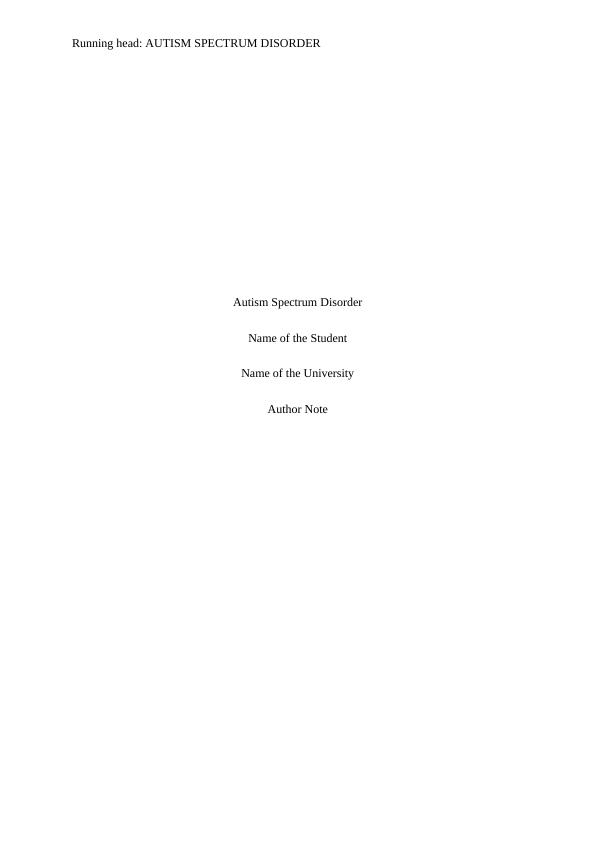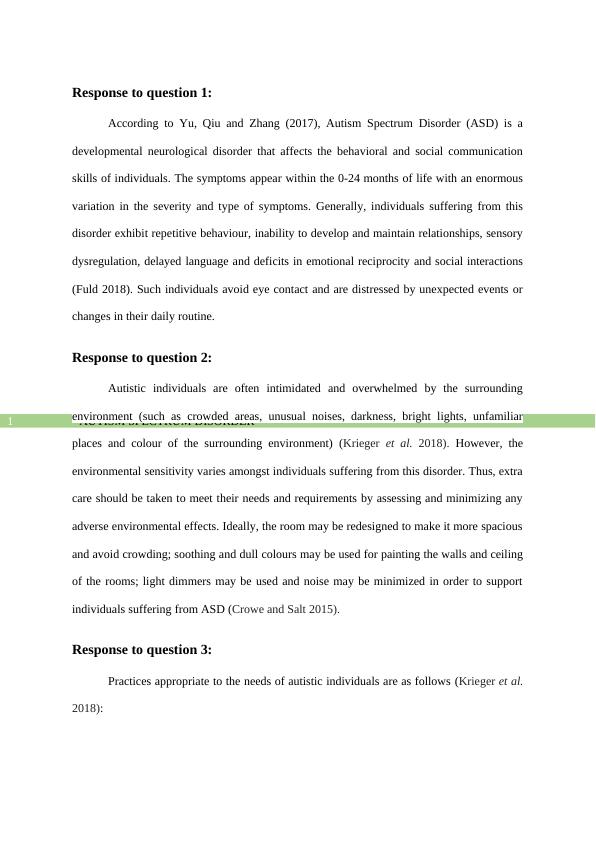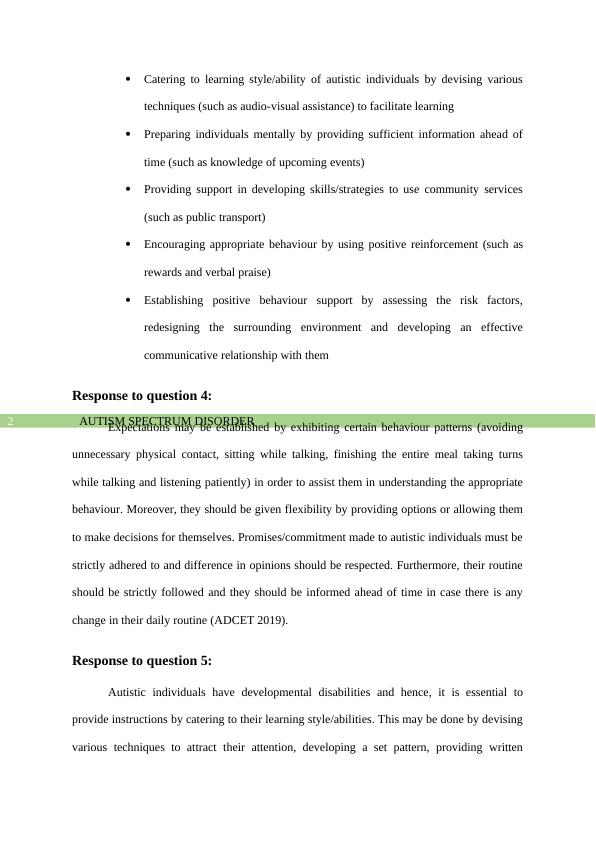Autism Spectrum Disorder
Added on 2022-11-17
9 Pages1772 Words117 Views
Running head: AUTISM SPECTRUM DISORDER
Autism Spectrum Disorder
Name of the Student
Name of the University
Author Note
Autism Spectrum Disorder
Name of the Student
Name of the University
Author Note

AUTISM SPECTRUM DISORDER1
Response to question 1:
According to Yu, Qiu and Zhang (2017), Autism Spectrum Disorder (ASD) is a
developmental neurological disorder that affects the behavioral and social communication
skills of individuals. The symptoms appear within the 0-24 months of life with an enormous
variation in the severity and type of symptoms. Generally, individuals suffering from this
disorder exhibit repetitive behaviour, inability to develop and maintain relationships, sensory
dysregulation, delayed language and deficits in emotional reciprocity and social interactions
(Fuld 2018). Such individuals avoid eye contact and are distressed by unexpected events or
changes in their daily routine.
Response to question 2:
Autistic individuals are often intimidated and overwhelmed by the surrounding
environment (such as crowded areas, unusual noises, darkness, bright lights, unfamiliar
places and colour of the surrounding environment) (Krieger et al. 2018). However, the
environmental sensitivity varies amongst individuals suffering from this disorder. Thus, extra
care should be taken to meet their needs and requirements by assessing and minimizing any
adverse environmental effects. Ideally, the room may be redesigned to make it more spacious
and avoid crowding; soothing and dull colours may be used for painting the walls and ceiling
of the rooms; light dimmers may be used and noise may be minimized in order to support
individuals suffering from ASD (Crowe and Salt 2015).
Response to question 3:
Practices appropriate to the needs of autistic individuals are as follows (Krieger et al.
2018):
Response to question 1:
According to Yu, Qiu and Zhang (2017), Autism Spectrum Disorder (ASD) is a
developmental neurological disorder that affects the behavioral and social communication
skills of individuals. The symptoms appear within the 0-24 months of life with an enormous
variation in the severity and type of symptoms. Generally, individuals suffering from this
disorder exhibit repetitive behaviour, inability to develop and maintain relationships, sensory
dysregulation, delayed language and deficits in emotional reciprocity and social interactions
(Fuld 2018). Such individuals avoid eye contact and are distressed by unexpected events or
changes in their daily routine.
Response to question 2:
Autistic individuals are often intimidated and overwhelmed by the surrounding
environment (such as crowded areas, unusual noises, darkness, bright lights, unfamiliar
places and colour of the surrounding environment) (Krieger et al. 2018). However, the
environmental sensitivity varies amongst individuals suffering from this disorder. Thus, extra
care should be taken to meet their needs and requirements by assessing and minimizing any
adverse environmental effects. Ideally, the room may be redesigned to make it more spacious
and avoid crowding; soothing and dull colours may be used for painting the walls and ceiling
of the rooms; light dimmers may be used and noise may be minimized in order to support
individuals suffering from ASD (Crowe and Salt 2015).
Response to question 3:
Practices appropriate to the needs of autistic individuals are as follows (Krieger et al.
2018):

AUTISM SPECTRUM DISORDER2
Catering to learning style/ability of autistic individuals by devising various
techniques (such as audio-visual assistance) to facilitate learning
Preparing individuals mentally by providing sufficient information ahead of
time (such as knowledge of upcoming events)
Providing support in developing skills/strategies to use community services
(such as public transport)
Encouraging appropriate behaviour by using positive reinforcement (such as
rewards and verbal praise)
Establishing positive behaviour support by assessing the risk factors,
redesigning the surrounding environment and developing an effective
communicative relationship with them
Response to question 4:
Expectations may be established by exhibiting certain behaviour patterns (avoiding
unnecessary physical contact, sitting while talking, finishing the entire meal taking turns
while talking and listening patiently) in order to assist them in understanding the appropriate
behaviour. Moreover, they should be given flexibility by providing options or allowing them
to make decisions for themselves. Promises/commitment made to autistic individuals must be
strictly adhered to and difference in opinions should be respected. Furthermore, their routine
should be strictly followed and they should be informed ahead of time in case there is any
change in their daily routine (ADCET 2019).
Response to question 5:
Autistic individuals have developmental disabilities and hence, it is essential to
provide instructions by catering to their learning style/abilities. This may be done by devising
various techniques to attract their attention, developing a set pattern, providing written
Catering to learning style/ability of autistic individuals by devising various
techniques (such as audio-visual assistance) to facilitate learning
Preparing individuals mentally by providing sufficient information ahead of
time (such as knowledge of upcoming events)
Providing support in developing skills/strategies to use community services
(such as public transport)
Encouraging appropriate behaviour by using positive reinforcement (such as
rewards and verbal praise)
Establishing positive behaviour support by assessing the risk factors,
redesigning the surrounding environment and developing an effective
communicative relationship with them
Response to question 4:
Expectations may be established by exhibiting certain behaviour patterns (avoiding
unnecessary physical contact, sitting while talking, finishing the entire meal taking turns
while talking and listening patiently) in order to assist them in understanding the appropriate
behaviour. Moreover, they should be given flexibility by providing options or allowing them
to make decisions for themselves. Promises/commitment made to autistic individuals must be
strictly adhered to and difference in opinions should be respected. Furthermore, their routine
should be strictly followed and they should be informed ahead of time in case there is any
change in their daily routine (ADCET 2019).
Response to question 5:
Autistic individuals have developmental disabilities and hence, it is essential to
provide instructions by catering to their learning style/abilities. This may be done by devising
various techniques to attract their attention, developing a set pattern, providing written

End of preview
Want to access all the pages? Upload your documents or become a member.
Related Documents
ASD and Educational Provisionlg...
|44
|13100
|154
Special Education Needs in Early Years Settingslg...
|7
|1353
|77
Assignment on Autism Cliniclg...
|5
|646
|18
